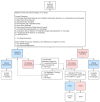Infectious Keratitis Management: 10-Year Update
- PMID: 40943747
- PMCID: PMC12429233
- DOI: 10.3390/jcm14175987
Infectious Keratitis Management: 10-Year Update
Abstract
Infectious keratitis (IK), including bacterial, fungal, parasitic, and viral etiologies, continues to represent a significant cause of ocular morbidity in the United States and around the world. Corneal scraping for smears and cultures remains the gold standard in diagnosing IK; however, molecular diagnoses, including metagenomic deep sequencing (MDS), are promising emerging diagnostic tools. Despite recent interest in procedural treatment such as riboflavin photoactivated chromophore corneal collagen cross-linking (PACK-CXL) and Rose Bengal photodynamic antimicrobial therapy (RB-PDAT), medical treatment advances have remained stagnant. Methods: This review highlights IK pathogens obtained from corneal cultures at Bascom Palmer Eye Institute (BPEI) from 2011 to 2021 and provides the current BPEI algorithms for initial management of IK or as a referred clinically worsening patient. The roles of corticosteroid therapy, PACK-CXL, and RB-PDAT for IK are also summarized. Results: A total of 9326 corneal cultures were performed at BPEI between 2011 and 2021, and only 3609 (38.7%) had a positive organism identified, of which bacteria were the most common (83.4%). Fortified vancomycin and tobramycin are recommended as first-line medical therapy for IK patients based on culture sensitivity data for the top Gram-negative (Pseudomonas aeruginosa) and Gram-positive (Staphylococcus aureus) bacteria. PACK-CXL and RB-PDAT may benefit IK patients with corneal melting and fungal IK, respectively. Conclusions: Drug holidays, minimizing contamination, and optimizing sample order are crucial to maximizing corneal culture positivity. PACK-CXL and RB-PDAT are promising procedural advancements for IK therapy.
Keywords: antimicrobial therapy; corneal ulcer; infectious keratitis.
Conflict of interest statement
Guillermo Amescua: Rose Bengal Photodynamic Antimicrobial Therapy (Patent, University of Miami). The remaining authors declare no conflicts of interest.
Figures



References
-
- Flaxman S.R., Bourne R.R., Resnikoff S., Ackland P., Braithwaite T., Cicinelli M.V., Das A., Jonas J.B., Keeffe J., Kempen J.H., et al. Global causes of blindness and distance vision impairment 1990–2020: A systematic review and meta-analysis. Lancet Glob. Health. 2017;5:e1221–e1234. doi: 10.1016/S2214-109X(17)30393-5. - DOI - PubMed
Publication types
Grants and funding
LinkOut - more resources
Full Text Sources
Research Materials
Miscellaneous

